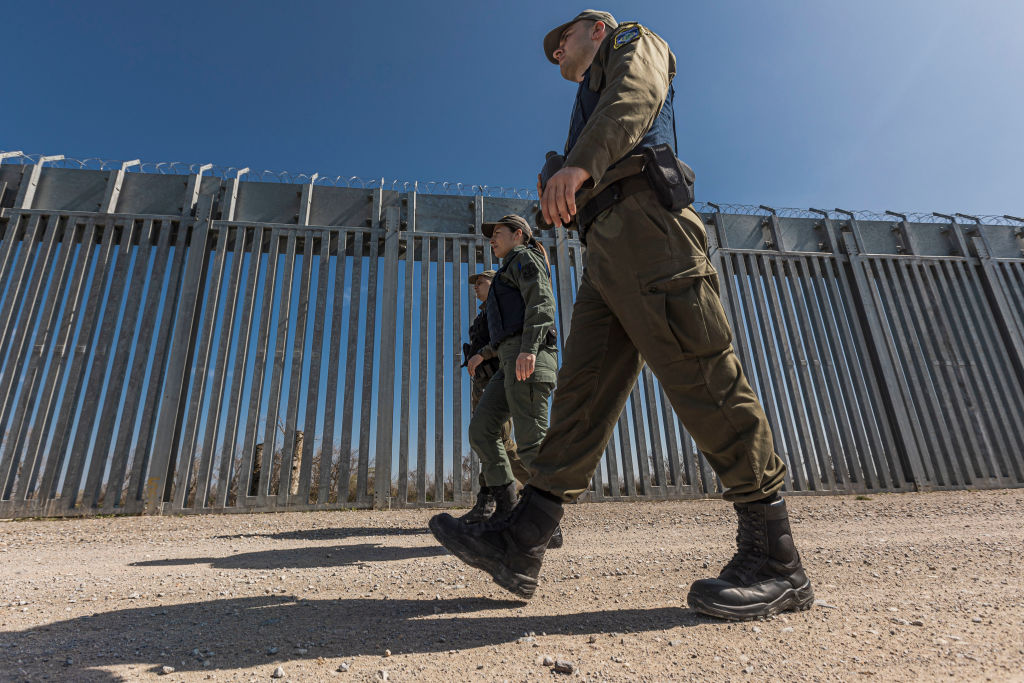Europe looks set to clamp down on migrants even further. A new E.U. Pact on Migration and Asylum, a major overhaul being hammered out, is due to come into force next year and will harden border procedures, accelerate deportations, and much else.
[time-brightcove not-tgx=”true”]
U.S. President Donald Trump and MAGA figures frequently warn that Europe has lost control of migration. But the facts are very different. Over the past decade, the continent has built a big, largely invisible fortress—one that carries enormous economic and moral risks. Member states have tightened asylum procedures, struck deals with transit countries including Turkey, Libya, Tunisia, and Egypt, and deployed more surveillance technology than ever before.
And this has yielded results. Across the continent, irregular crossings have fallen sharply since the peaks of 2015–2016 and again since the post-pandemic rebound. The E.U.’s border agency, Frontex, reports that the total number of irregular crossings in 2024 was 40% lower than in the previous year, and has fallen further in the first half of 2025.
Governments across Europe are also responding to the threat of the far right by making life harder for regular migration—from Germany’s tightening of migration rules to Sweden’s tightening of residency ones. Migration has in turn fallen significantly in 2024.
At first glance, this may look like success, both in terms of policy and politics. European leaders can tell anxious voters that they have “taken back control” of borders while maintaining the continent’s humanitarian commitments and avoiding the sort of footage we have seen in the U.S. of masked ICE agents snatching people off the streets. At least on paper, this enables them to claim moral superiority over the Trump Administration’s disregard of both international and domestic legal norms, while—they hope—fending off the threat of the far-right.
But the reality is less reassuring. Europe’s new fortress is not built on solid economic or social foundations.
The first issue is moral and humanitarian. Europe’s crackdown has not stopped people from moving; it has simply made their journeys longer, costlier, and riskier. More than 2,000 people died or went missing trying to cross the Mediterranean in 2024. Outsourcing border control to countries such as Libya or Tunisia may reduce the number of arrivals on European shores, but it also means that Europe is often subcontracting human rights abuses. Officially, the E.U. has said it would not tolerate practices like illegal pushbacks; in practice, they continue to be used to keep arrivals down.
But it is the economic and political contradiction that will ultimately doom this policy. Europeans are both living longer and having fewer babies. The result is an ageing population and a shrinking workforce. Germany needs around 300,000 new workers a year; Italy and Spain likewise need many more new workers. The OECD has long argued that higher levels of immigration are essential to address labor shortages in the short term and to boost growth in the long term.
Governments are well aware of this. Italy’s far-right government has, paradoxically, quietly expanded work permits for non-E.U. migrants, while Germany is reforming its points-based immigration system.
But these pragmatic steps are often drowned out by the louder politics of deterrence. Europe’s leaders fear that admitting the need for more migrants will hand ammunition to the far right. The result is paralysis: a continent that simultaneously says, “we need you” and “keep out.” This is unlikely to be a stable equilibrium; it gives the illusion of control while storing up political and economic trouble for the future.
So, what comes next? Broadly, Europe faces three choices.
The first is to maintain and intensify the “fortress Europe” policy. But that will undermine growth, strain public finances, and erode Europe’s capacity to fund its prized welfare state. The result will not be to marginalize the far right but give it further ammunition; this in turn will alienate Europe’s existing population of migrant origin and undermine social cohesion.
The second option is the traditional European approach: muddling through. But the result will be an unstable mix of crackdowns, loopholes, and crises. Under this scenario, irregular migration continues, driven by desperation abroad and labor demand at home. Europe responds with ad hoc deals, emergency summits, and moral panics. This approach is politically messy, administratively costly, and inhumane. This too is a gift to the far right.
There is a better, third option. It starts with officials acknowledging that Europe needs migrants. It requires building better and more flexible pathways for work and refuge, investing more in integration, and revamping the asylum system to make it swift, efficient, and humane. Managed migration cannot eliminate irregular flows, but it can make a difficult situation better.
None of this is easy. Even well-designed systems face backlash in uncertain economic times. Defeating the populist right will require restoring productivity growth and boosting living standards—openness to immigration will be necessary to delivering this, but by no means sufficient. The factors that drive migration will not vanish—and “open borders” is not an option, politically or practically, meaning border enforcement and enforced removals for those with no legal right to remain will always be necessary.
But pretending that migration can or should be stopped is a dangerous illusion.

